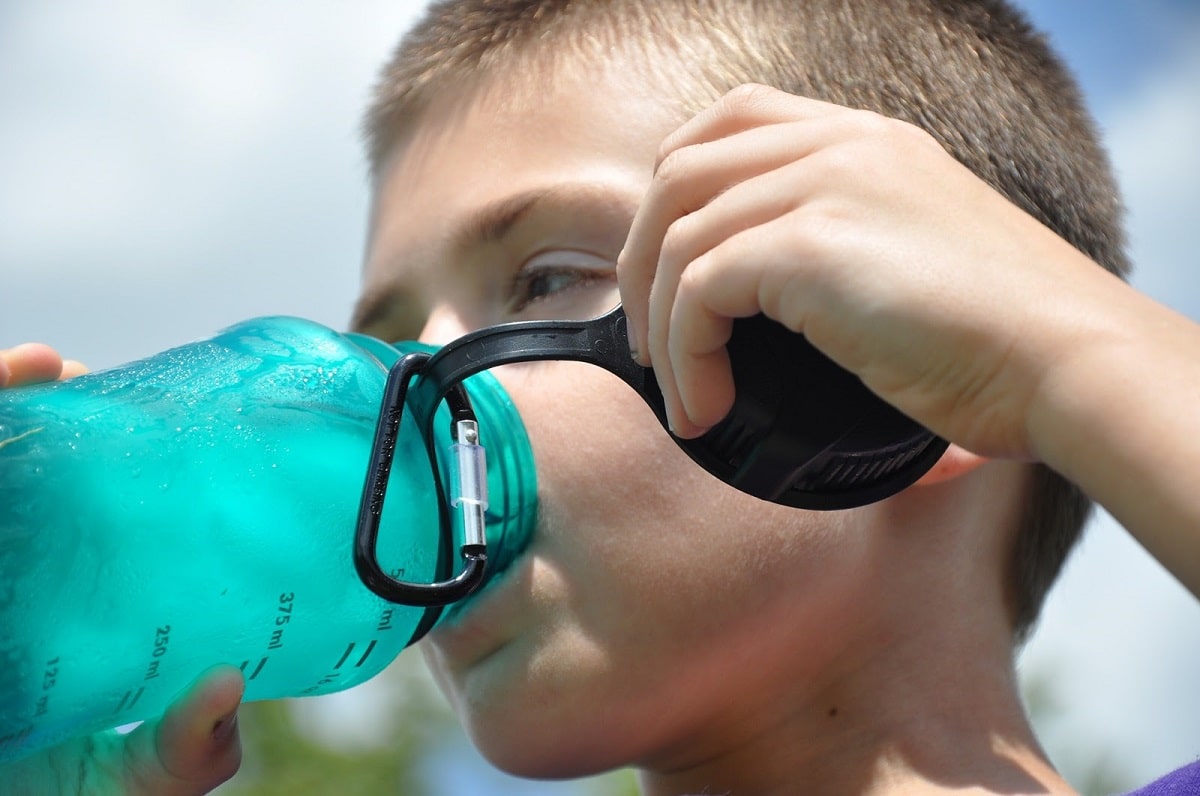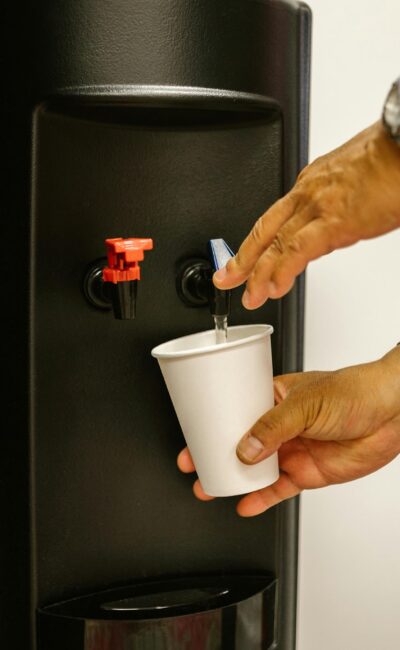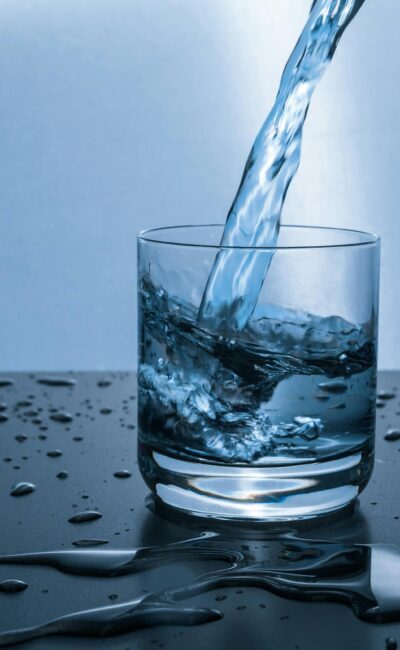The importance of hydration to maintain good health isn’t breaking news. It’s been well-established that eight, 8-oz. glasses of water per day is generally preferable. The link between hydration and learning is impactful for students’ energy levels and brain function by helping to decrease the frequency of headaches, anxiety, and fatigue. Dealing with any of these symptoms on a recurring basis can negatively affect a student’s school performance and extracurricular activities. It’s important to provide clean, free drinking water in multiple areas by way of hydration stations.
Although someone may not automatically feel dehydrated, it happens more frequently than you’d think and can easily zap energy and reduce the ability to focus or do well in school. Children may not want to slow down to rehydrate and only drink water intermittently in favor of sugary beverages like sodas and energy drinks. Water is the key to maintaining proper hydration and keeping students healthy. Among the other health benefits of water are:
- Aids in digestion and weight loss
- Helps to detoxify the body
- Regulates body temperature
- Protects the kidneys
- Alleviates headaches
- Promotes cardiovascular health
Staying hydrated keeps the mind sharp. It promotes adequate blood flow, which is affected by blood pressure and is directly related to the amount of water we drink. Over time, without enough water, there’s a reduction of blood flow to the brain. This produces a “brain fog” or the inability to concentrate for long periods of time. Hydration stations and reusable water bottles are the answer to providing a purified water source for students throughout the day, as well as teachers and other school staff who may want to maintain their water intake as well.
The Centers for Disease Control reports that U.S. adolescents who drink less water tend to eat fewer fruits and vegetables, eat more fast food, and get less physical activity. A focus on hydration helps to create healthier habits in kids. As more hydration stations for schools are introduced, the effect on the level of student performance and wellness will likely increase as well. Fortunately, there have been advances in how water is made available for public consumption. It’s better-tasting and safer to drink now than it’s been in the past.
Installing hydration stations for public schools will continue to be a growing need as more people discover all of the benefits they provide. They help to remedy health issues commonly linked to shared water fountains, provide an alternative to unhealthy drinks, reduce plastic waste, encourage better hydration, and give children a way to get enough water on a daily basis and keep them well-hydrated. This overview explores each benefit more in-depth to uncover just how valuable this advanced solution is and how it can improve public schools.
Remedy Health Issues Associated With Water Fountains
For decades, schools have relied on public drinking fountains to help hydrate students throughout the day. Waiting in line between classes to get a drink wasn’t uncommon in the days before bottled water and vending machines in schools, which arrived years later. However, there have been numerous studies and reports that have reviewed the risks of drinking from a water fountain. They can be a breeding ground for germs and other contaminants. In some cases, they aren’t well-maintained or inspected on a frequent basis.
The importance of distributing safe drinking water in schools during mealtimes is part of the standards and regulations set forth by the Environmental Protection Agency. Schools that don’t follow regular quality testing may expose students to water with lead and other harmful impurities. During cold and flu season, germs are easily spread by continually making contact with the faucet button or switch and with the mouth of the faucet itself.
With a water refill station like FloWater’s, there’s a large fill area that fits any size container and keeps the two surfaces from ever touching. Also, the one-touch fill feature means there’s no lingering contact where germs can spread. The design of the fill station also prevents the build-up of grime and standing water, which eliminates mold growth and other bacteria from settling in.
Depending on the condition of the pipe system of each school water fountain, there could be trace elements or chemicals that haven’t been filtered from the water. These could cause health issues and damage to the organs and systems in the body. The advanced purification system in the FloWater Water Refill Station goes through seven levels of advanced filtration to eliminate 99% of impurities from the tap water before it’s ready to drink.
School Water Fountains require constant maintenance and cleaning to remain sanitary, which can take a toll on staff members. Alternatively, with a FloWater school water bottle refill station there is little maintenance required and activated oxygen provides chemical-free sanitization for the internal system so manual cleaning is not required.
Provide an Alternative to Sugary Drinks
Doctors report drinking water only (versus flavored drinks or sodas) as part of a daily fluid intake because the body spends energy trying to remove chemicals found in sugary drinks or beverages with unnatural additives. Sodas or sports drinks may also contain ingredients that can cause overstimulation, such as caffeine and sugar, making it difficult for concentration. These may provide a sudden boost of energy only to crash soon after. Customer research shows well-hydrated students are:
- More alert throughout the school day
- Have more focus and are better able to concentrate in class
- Perform better on tests and extracurriculars
Hydration stations for schools is a cost-effective way to provide a constant, clean water supply to students for free. For many schools who are cutting back on sodas and other unhealthy food and drink options, the refill station is an obvious choice to give students and staff purified water without sacrificing taste, convenience, or affordability. This is extra helpful for student-athletes who are active in sports. Stations set up near locker rooms, gyms, and outdoor playing fields suit a high-volume location without taking up too much space.
The FloWater Water Refill Station is slim and stands at 68” x 18” x 16” to perfectly fit into most areas. No more lugging heavy water jugs or relying on an endless stream of plastic or paper cups that will cause litter and more strain on the environment. Plus, the waiting line for water only lasts a few seconds since it takes 9 seconds to fill a 24-oz. bottle. For kids in a hurry, it lets them get what they need and be on their way quickly.
Reduce Plastic Waste and Promote Sustainability in Schools
Bottled water hit a big trend in the late 90s and into the 2000s due to its convenience and push for “great-tasting” filtered water from various water springs and natural sources. The drawback from this type of water solution is the effect of plastic waste on the environment. Tens of thousands of plastic water bottles end up in the ocean, disrupting marine life and eventually, fish and seafood consumed by humans. This is in addition to the majority of plastic waste that ends up in landfills rather than being recycled. While the convenience of portable, plastic bottles was nice in theory, the trade-off isn’t worth it.
This generation of students is drawn to brands and products that provide more sustainable options. One global survey identifies 51% of Gen Zers cut energy consumption as a way to promote sustainability, while 42% use low-energy products. Additionally, nearly half spent more (or are willing to spend more) to buy from sustainable companies and 31% have boycotted non-sustainable companies outright. Now more than ever, people are concerned about the environment and want to do their part in helping to eliminate plastic waste and promote more eco-conscious solutions. It’s not only adults who want to help the planet; it’s starting at the student level, too.
Fortunately, hydration solutions have evolved further and there are now sustainable options that filter water, provide great taste, and are good for the environment all at the same time. The FloWater Water Refill Station hits all of these high points and has created an opportunity for schools to provide students with the hydration they need to stay focused and ready to take on the school day. Thanks to these eco-friendly stations, there is a decrease in plastic waste on campuses and an increase in students choosing to drink water on a more regular basis.
Encourage Better Hydration With Better Tasting Water
One common sentiment kids may have is that they don’t like the taste of water from the tap. Who can blame them when many water sources still have several chemicals or other components that can leave a foul-smelling odor or lingering aftertaste? This alone can steer them in the direction of bottled water or other unhealthy drink options. Since it’s been shown that teens and young adults want to do their part for the planet and like the idea of reusable water bottles, the solution is clear. Give them water worth drinking.
With FloWater, this is achieved by a water purification system that filters tap water seven times. The first three steps focus on purifying the water, the second three focus on improving the taste, and the last step finishes the process by filtering through real coconut husks to result in a crisp, delicious flavor. Typical tap water contains a number of impurities that can alter the taste, and FloWater’s 7x Advanced Purification System eliminates up to 99% of them. Although many water filters may catch dirt, rust, and other solid impurities like in the first step of this filtration system, they don’t remove the rest.
The carbon filter of the purification system removes smaller particles found in tap water like hydrogen sulfide and chlorine, which removes odors and unpleasant tastes. Then, the third filter of advanced osmosis removes contaminants like bacteria, lead, heavy metals, and pesticides that may have made its way into your water source. It is five times more efficient in water purification than anything else currently available. In steps four and five, small amounts of activated oxygen are added to the water to sanitize the tanks and internal system and trace minerals are added through the alkaline filter to raise the pH level of the tap water. A higher pH level can help neutralize acidity in the body caused by stress, environmental factors, and an unbalanced diet, which helps to relieve stress on the internal organs.
Finally, before the coconut carbon filter, electrolytes including magnesium, potassium, sodium, and calcium are added to support healthy body function such as cell repair, bone strength, and immune defense, while keeping you energized. Each step is specially designed to either remove what’s impure about tap water or enhance the flavor and health benefits water provides.
The Positive Effects of School Hydration Stations
Well-hydrated students have a better chance of performing better in school due to increased focus, improved energy, and added health benefits for the body. A more sanitary place to fill up a water bottle leads to less spreading of germs and fewer sick days during the school year. The less plastic bottles are available, the more positive impact it has on the planet. All it takes is the right solution strategically placed for maximum consumption, which is why it’s important to consider hydration stations for schools.
In fact, consumer research shows FloWater water dispensers have increased clean water consumption by 250% on average across campuses, 87% more students trust FloWater over water fountains, and 86% prefer the taste of FloWater over water fountains. The swap is a welcome change for students and gives them benefits they may not have initially thought about. The more students grow accustomed to a new way of having access to purified water and learning how to enjoy the effects of what that water provides, the better it is for their school life.
Water fountains and plastic water bottles are no longer the go-to solutions as a constant water source. The standard has been raised of what we can now expect. And, the solution comes with a focus on healthy habits, less cost, reduced plastic pollution, and an overall better outlook on maintaining optimal hydration for students.
Sources:
https://www.cdc.gov/nutrition/data-statistics/plain-water-the-healthier-choice.html
https://www.healthline.com/nutrition/7-health-benefits-of-water#section3
https://pacinst.org/wp-content/uploads/2017/02/Drinking_Fountains_and_Public_Health_Feb_2017-1.pdf
https://www.eugene-or.gov/DocumentCenter/View/38412/Masdar-Gen-Z-Global-Sustainability-Survey-Infographics; https://www.medexpress.com/about/newsroom/press-releases-media-coverage/medexpress-benefits-water.html





